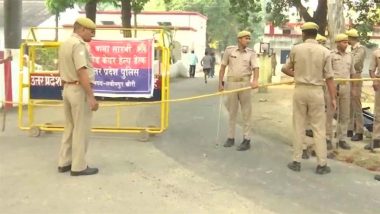Mahashivratri 2205 will be celebrated on February 26. This annual observance, which is celebrated on the Shivratri that falls in the month of Phalguna, is believed to mark the wedding of Shiva and Parvati and the occasion that Shiva performs his divine dance, called the Tandava. While each month has its own Shivratri observance, Mahashivratri is considered to be the most auspicious holiday for devotees of Lord Shiva. To commemorate this day, people often hold night vigils singing songs and appeasing Lord Shiva. Visiting Shiva temples and making offerings of milk and belpatta are also common practices on this day. This is the reason that most devotees often schedule a visit to the most auspicious Shiva temples across the country - the 12 Jyotirlingas - to celebrate Mahashivratri. These temples are believed to embody Lord Shiva’s infinite and unchanging nature, with each location highlighting one attribute of the Almighty. As we prepare to celebrate Mahashivratri 2025, here are the names of all 12 Jyotirlingas, where they are located and what their significance is. Mahashivratri 2025 Date: The Meaning, Power and Significance of Chanting ‘Om Namah Shivaya’ To Celebrate the Great Night of Shiva.
1. Somnath: Located in Veraval, Saurashtra, Gujarat
The Somnath temple is considered to be one of the most prominent and popular of the Jyotirlingas. Also referred to as Prabhasa or place of splendour, it is believed to be the first Jyotirlinga where Lord Shiva manifested himself as an eternal pillar of light.
2. Mallikarjuna: Located in Srisailam, Andhra Pradesh
The second Jyotirlinga to be marked was Jyotirlinga. According to legend, Lord Shiva and Goddess Parvati followed Lord Kartikeya to Srisailam, showing his unconditional love and care as a father. It is believed that the presiding deity in the form of Linga (an iconic form of Shiva) was worshipped with jasmine (locally called in Telugu as Mallika), leading to the name Mallikarjuna.
3. Mahakaleshwar: Located in Ujjain, Madhya Pradesh
Mahakaleshwar in Ujjain is one of the most popular Jyotirlingas, visited by devotees of Lord Shiva with great fervour and enthusiasm. The temple is also revered as one of the 18 Shakti Peetham, which means that Goddess Shakti also resides here. At this temple, Lord Shiva is represented as the eternal cosmic force beyond life and death.
4. Omkareshwar: Located in Khandwa, Madhya Pradesh
Located merely 140 km away from the Mahakaleshwar temple, Omkareshwar is one of the two Shiva temples created in this area. The other is Mamleshwar (Amaleshwar) (whose name means "Immortal Lord" or "lord of the Immortals or Devas"). It is believed that the Hindu legend, Vindhya, was dedicated to worshipping Lord Shiva. He created a Lingal out of clay and sand to appease the almighty. Shiva was pleased with the worship and believed to have appeared in two forms, namely Omkareshwar and Amaleswara.
5. Rameswaram: Located in Setubandh
Located in Rameshwaram Island in Tamil Nadu, the Ramanathaswamy Temple is one of the most secluded and scenic Jyotirlingas. According to tradition, the lingam (an aniconic form of Shiva) of the Ramanathaswamy Temple was established and worshipped by Lord Ram before he crossed the bridge called Rama Setu to the island kingdom of Lanka. This is what makes the temple extremely auspicious for not just devotees of Lord Shiva but also devotees of Lord Ram.
6. Nageshwar: Located in Darauka-Vana
Nageshwar Temple in Dwarka, Gujarat, is believed to be one of the legendary temples mentioned in the Shiva Purana. The temple is believed to represent Lord Shiva’s role as the ultimate protector and liberator from worldly and spiritual bondage.
7. Vishwanath: Located in Varanasi
The Kashi Vishwanath Temple in Varanasi is a popular pilgrimage site that is often visited even beyond its inclusion in the 12 Jyotirlingas. It is believed that Varanasi is the first Jyotirlinga to manifest itself. This is believed to be the place where Lord Shiva manifested as an infinite column of light (Jyotirlinga) in front of Brahma (the Hindu god of creation) and Vishnu (the Hindu god of preservation) when they had an argument about their supremacy.
8. Trimbakeshwar: Located in Nashik, Maharashtra
The Trimbakeshwar is believed to be one of the few Jyotirlingas where Lord Shiva resides along with Lord Brahma and Lord Vishnu. The Trimbakeshwar Temple does not have the traditional Lingam. Instead, the lingam has three faces representing the Hindu trinity: Brahma, Vishnu, and Shiva.
9. Baidyanath: Located in the Santhal Parganas division of Jharkhand
Baidyanath Temple in Deoghar, Jharkhand, is another popular Jyotirlinga with a rich history. It is believed that the Shiva lingam in this temple has been permanently damaged by Ravana. According to legends, it was the Shivling that Ravan wanted to carry back to Lanka. However, Lord Brahma and Lord Vishnu concocted a plan that helped them keep the lingam nearby. Angered by this plan, Ravana pressed his thumb onto the lingam before departing, which partially damaged the Shiva Lingam. The Shiva lingam was then worshipped by Brahma, Vishnu, and other deities, and they constructed the Baidyanath Temple.
10. Bhimashankar: Located in Pune, Maharashtra
The Bhimashankar Temple is a noted Jyotirling, and the second one, that is located in Maharashtra. The Bhima river is believed to originate in this region. The Bhimashankar Temple was constructed during the 18th century by Nāna Phadnavis of Peshwa. This temple is associated with the story of Lord Shiva and the demon Bhima. It is believed that to protect his devotees and maintain peace, Lord Shiva manifested himself in the form of a Jyotirlinga, which came to be known as Bhimashankar Jyotirlinga.
11. Kedarnath: Located in Kedarnath, Uttrakhand
The Kedarnath temple is addressed in various mythological texts. According to legends, the Pandavas built this Shiv temple. The temple was covered in snow for over 400 years before Adi Shankaracharya discovered it in the 8th century. The main idol of Lord Shiva in the temple is a conical three-faced lingam in the shape of a bull's hump.
12. Grishneshwar: Located in Chhatrapati Sambhaji Nagar, Maharashtra
The Grishneshwar Jyotirlinga is the third Jyotirlinga that is located in Maharashtra. The mandir is a nationally protected site, one and a half kilometres away from the Ellora Caves. It is said to be the smallest Jyotirlinga in the country and has Dashavataras (the ten incarnations of Lord Vishnu) leading up to the main temple.
We hope that this information helps you understand the relevance of each of the 12 Jyotirlingas. It is believed that Lord Shiva has a strong connection to each of the 12 Jyotirlingas. Each location represents the divine presence and stories of Lord Shiva in its own way. Visiting these locations on the special occasion of Mahashivratri is believed to help appease Lord Shiva and seek his blessings. Here’s wishing everyone a Happy Maha Shivratri.
(The above story first appeared on LatestLY on Feb 24, 2025 02:49 PM IST. For more news and updates on politics, world, sports, entertainment and lifestyle, log on to our website latestly.com).













 Quickly
Quickly





















